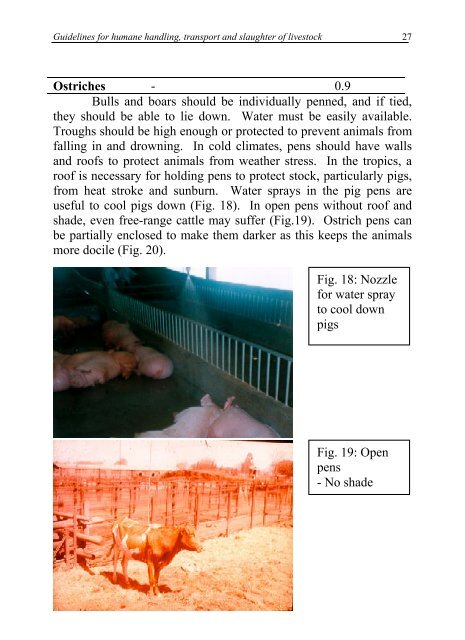Guidelines for humane handling, transport and slaughter of
Guidelines for humane handling, transport and slaughter of
Guidelines for humane handling, transport and slaughter of
Create successful ePaper yourself
Turn your PDF publications into a flip-book with our unique Google optimized e-Paper software.
<strong>Guidelines</strong> <strong>for</strong> <strong>humane</strong> <strong>h<strong>and</strong>ling</strong>, <strong>transport</strong> <strong>and</strong> <strong>slaughter</strong> <strong>of</strong> livestock 27<br />
Ostriches - 0.9<br />
Bulls <strong>and</strong> boars should be individually penned, <strong>and</strong> if tied,<br />
they should be able to lie down. Water must be easily available.<br />
Troughs should be high enough or protected to prevent animals from<br />
falling in <strong>and</strong> drowning. In cold climates, pens should have walls<br />
<strong>and</strong> ro<strong>of</strong>s to protect animals from weather stress. In the tropics, a<br />
ro<strong>of</strong> is necessary <strong>for</strong> holding pens to protect stock, particularly pigs,<br />
from heat stroke <strong>and</strong> sunburn. Water sprays in the pig pens are<br />
useful to cool pigs down (Fig. 18). In open pens without ro<strong>of</strong> <strong>and</strong><br />
shade, even free-range cattle may suffer (Fig.19). Ostrich pens can<br />
be partially enclosed to make them darker as this keeps the animals<br />
more docile (Fig. 20).<br />
Fig. 18: Nozzle<br />
<strong>for</strong> water spray<br />
to cool down<br />
pigs<br />
Fig. 19: Open<br />
pens<br />
- No shade
















